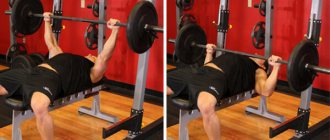Many dieters exercise to lose weight. But sometimes they exercise too often, and as a result they overeat. Or they train too little and don't see results on the scale. Therefore, we will tell you exactly how much training is required to lose weight.
Scientific research and experts provide recommendations for training to lose weight, both daily and weekly, and not only for overweight people, but also to prevent gaining extra pounds.
It is important to understand:
- Exercise alone will not solve the problem of excess weight.
- Regular physical activity must be combined with a calorie deficit in the diet.
- In order to achieve your goal, you should try to exercise every 2 days.
To lose weight, you need to burn more calories than you consume.
Simply starting to eat fewer calories is not the solution. Anyone following a strict diet is unlikely to be able to maintain it for a long time. He will soon get tired of these food restrictions, and he will simply stop torturing himself, because not many people can remain hungry and tired all the time.
When a person switches back to a “regular” diet, they will likely regain all the weight they lost.
In most cases, this is what happens: a person who relies only on a diet will end up quickly gaining back all of the lost weight, and possibly even more.
This can all become a nightmare cycle - you go on a strict diet, crash, then your excess weight comes back and you have to go on a diet again.
Weight Loss Recommendations
Medical experts have studied different recommendations for the amount of exercise per week. The study results suggest that for weight loss, it is recommended to exercise between 150 and 250 minutes per week of moderate to vigorous intensity exercise. But they also argue that the more training, the better. For maximum fast and noticeable results, it is recommended to do more than 250 minutes of intense exercise per week.
To lose weight and not allow it to return when the desired result is achieved, you need to approach the decision from two sides:
- It is necessary to maintain an energy balance in your diet - do not consume more calories in food than you expend.
- Exercise regularly because exercise helps burn fat and build muscle, and proper nutrition will supply the muscles with the necessary substances for proper growth.
How often to exercise to lose pounds?
If you want to lose weight, then you should exercise once every 2 days. To build muscle mass, training must be hard. If the muscles don't work hard, they simply won't grow.
But muscle work is only part of the solution. They also need to be given time to recover after training. For example, strength training should only be done every 48 hours to give the body time to rest.
In between strength training sessions, you can do cardio exercises that get your heart rate up to burn more fat.
How often do you need to exercise to see results?
When a person first begins to gain muscle mass and lose fat, they may notice changes in their appearance, but their weight remains the same. It may even increase. But there is no need to worry about this, since a kilogram of muscle weighs the same as a kilogram of fat, but muscle is more compact and dense, and takes up less space than fat. Therefore, your weight may remain the same, but you will look thinner.
Instead of watching the numbers on the scale to determine the effectiveness of your diet and exercise program, it is better to simply pay attention to changes in your appearance, the size of certain muscle groups, clothing, etc. You can also take measurements to evaluate progress. We first take measurements at the beginning of the fitness program, and then again after four or six weeks. This is a great way to determine the effectiveness of your plan. By then, of course, the volumes should change.
As a result, to the question “How often should you exercise to lose weight?” The answer would be strength training every 48 hours, and cardio between days with strength training to create variety and keep you motivated. It is also recommended to leave the day without any physical activity at all in order to give the body a chance to rest and fully recover.
How much to train per day?
- Approximately 150-250 minutes of moderate-intensity exercise per week is about 22-35 minutes per day.
- More than 250 minutes of moderate to vigorous intensity exercise per week will produce greater results. Aim for at least 35 minutes a day.
- If you want to cut calories a little (not too much), then 150-250 minutes of moderate-intensity exercise per week is perfect for you.
- At least 150-250 minutes of moderate intensity exercise is needed to prevent weight gain. Plan to get 22-35 minutes of exercise per day to maintain weight.
If you think that's too much and you don't think you can't do 22-35 minutes straight, then that's okay. You don't have to do the entire workout in one sitting. You don't even have to exercise every day. In general, there are many ways to change the duration and intensity of your workout in order to avoid getting tired or bored with it.
How many times a week should you exercise?
Since 250 minutes of physical activity per week is recommended, you've probably already started thinking that you should exercise every day. It's not obligatory. You can work out every second or even every third day at the gym or at home and still lose weight effectively.
Things to remember:
- Although there are generally accepted ways to calculate the amount of training, the correct answer depends on your characteristics
- Factors to consider include age, weight, health, type of work and personal goals.
- When you're lifting heavy weights, regardless of your goal, it's best to train each muscle group twice a week.
Individual characteristics such as age, weight and health desired goals should be taken into account. Additionally, the type of workout you choose should also be taken into account. Do you strength train, do cardio, or a combination of both?
Finally, the reason why you exercise is a major factor. Are you working to lose weight, gain muscle and strength, or just want to maintain a healthy lifestyle?
If you prefer short workouts, then it is better to exercise every day, devoting 20-35 minutes to exercise, this will be enough for weight loss, provided there is a calorie deficit in the diet. Exercising every day will also help you get used to physical activity.
But sometimes circumstances do not allow you to pay attention to sports every day. Then you will have to train every second day. But remember, the less often you exercise, the longer your workouts should be.
For example, if you do four 35-40 minute workouts and one 60-75 minute workout over the course of a week, you can skip a few days and still meet the weight loss requirements. If you have to miss a few days of the week, you can still train, you just have to make each session longer. But if you exercise less often, it will be more difficult to develop a habit of physical activity.
You can also vary the intensity of your workout. For example, if you are healthy enough to do high-intensity training, some sessions may be short and high-intensity, while others may be long but easier. If you are a beginner, then you can do simplified exercises of varying durations, for example, try jumping rope exercises for weight loss.
Global recommendations on physical activity for health
Prevention of non-communicable diseases
WHO developed the Global Guidelines on Physical Activity for Health with the overall goal of providing policy makers at national and regional levels with guidance on dose-response relationships between frequency, duration, intensity, type and overall the amount of physical activity needed to prevent non-communicable diseases.
- Global recommendations on physical activity for health
The recommendations outlined in this document are intended for three age groups: 5-17 year olds; 18-64 year olds; and people aged 65 years and older. Below is a section with recommendations for each age group.
Age group: children and teenagers (5-17 years old)
For children and young people in this age group, physical activity includes games, competitions, sports, travel, recreational activities, physical education or planned exercise within the family, school and community. To strengthen the cardiovascular system, musculoskeletal tissues and reduce the risk of non-communicable diseases, the following physical activity practices are recommended:
- Children and young people aged 5–17 years should engage in at least 60 minutes of moderate to vigorous intensity physical activity daily.
- Physical activity of more than 60 minutes per day will provide additional benefits to their health.
- The majority of daily physical activity should be aerobic exercise. Vigorous intensity physical activity, including exercise to develop musculoskeletal tissue, should be performed at least three times a week.
- Physical activity and young people
Age Group: Adults (18-64 years old)
For adults in this age group, physical activity includes recreational or recreational exercise, physical activity (such as cycling or walking), occupational activities (i.e. work), household chores, games, competitions, sports or routine activities. within daily activities, family and society.
In order to strengthen the cardiopulmonary system, musculoskeletal tissues, reduce the risk of non-communicable diseases and depression, the following physical activity practices are recommended:
- Adults 65 years of age and older should engage in at least 150 minutes per week of moderate-intensity aerobic activity, or at least 75 minutes per week of vigorous-intensity aerobic activity or equivalent moderate-to-vigorous physical activity.
- Each aerobics session should last at least 10 minutes.
- To reap additional health benefits, adults in this age group should increase their moderate-intensity aerobic activity to 300 minutes per week, or 150 minutes per week if vigorous-intensity aerobic activity, or a similar combination of moderate- and vigorous-intensity aerobic activity. .
- Adults in this age group with joint problems should do balance exercises to prevent falls 3 or more times per week.
- Strength training that involves major muscle groups should be done 2 or more days a week.
- If older people, due to their health conditions, cannot perform the recommended amount of physical activity, then they should engage in physical exercises taking into account their physical capabilities and health status.
- Physical activity and adults
Age Group: Elderly (65 years and above)
For adults in this age group, physical activity includes recreational or recreational exercise, physical activity (such as cycling or walking), professional activities (if the person continues to work), household chores, games, competitions, sports or scheduled activities. within the framework of daily activities, family and society.
- the same recommendations as for adults (given above), with the intensity and type of physical activity appropriate for older people; And
- exercises to maintain flexibility; And
- balance exercises.
- Physical activity and older people
Related links
- Complete information on physical activity
- Nutrition and physical activity: a public health priority
- Cardiovascular diseases
- Chronic diseases
- Mental health
How much training per day to lose 1 kilogram of fat?
If you are wondering how much you need to exercise to burn one kilogram of fat. Here you need to know that to burn 1 kilogram of fat in the body you need to spend 7000 calories. The exercises shown below will allow a person weighing 70 kilograms to lose one kilogram:
- 10 hours of easy running (at about 10 km per hour), i.e. about 1 hour 20 minutes per day.
- 28 hours of walking (5 kilometers per hour), about 4 hours a day.
- 10 hours of intense swimming, or about 1 hour 20 minutes per day.
- 13 hours of cycling (19-20 km/h), or just under 2 hours a day.
- 14 hours of intense aerobics, or 7 two-hour sessions per week.
This shows that losing one kilogram through physical activity alone is very difficult and takes a long time. It is for this reason that diet and exercise must be combined to induce a calorie deficit and weight loss.
If you feel like you'll never reach your workout goals, don't worry. Creating an effective training plan for weight loss is much easier than it seems at first glance.
The recommendations shown above will help you understand how much you need to train per day in order to lose weight. But remember that the most important thing is regularity and frequency of training. The smartest solution then would probably be to do less, but more often.
Weekly training program
Where to start training and when is the best time to exercise?! Below is an example of a simple weekly workout program that does not require the use of additional equipment and will take 30-45 minutes a day. It will give you a rough idea of how to get started from scratch and help you create your own fitness program.
It can be changed depending on your level of physical fitness and complicated as desired. It can start with any type of exercise.
Monday: 40 minutes of moderate jogging or brisk walking.
Tuesday: Rest day.
Wednesday: Brisk walking for 10 minutes. Next, perform the set of exercises below, resting for a minute after each set, not exercising. After that, stretch.
- First set of exercises: 3 sets of 10 lunges on both legs, 10 push-ups, 10 sit-ups from a supine position
- Second set of exercises: 3 sets of 10 chair push-ups, 10 stretches, 10 air squats
Thursday: Rest day.
Friday: 30 minutes cycling or jogging at a moderate pace
Saturday: Rest day.
Sunday: Run, jog or take a long walk for 40 minutes.
This program is just a simple example of how to start training from scratch.
Conclusion: There are a wide variety of exercises that you could easily do. The workout plan above is provided as an example to give you a general idea of where to start exercising at home.
How many times a week should you train to see results?
As you already know, to lose weight you need to burn more calories than you get from food.
Following a low-calorie diet is one way to cut calories, but the effect of a combination of diet and exercise will be much greater.
Therefore, in order to see the results of weight loss training, you need to carefully monitor the number of calories in your diet and if there are no changes in body weight or appearance, you need to cut your daily calorie intake by 300-500 calories.
When you simply diet, you lose weight by reducing fat and muscle. Reduced muscle mass slows down your metabolism, making it more difficult to lose weight and keep it off. Therefore, always include training in your plan, preferably strength training.
To lose weight, doctors recommend at least 30 minutes of any type of cardio per day, five times a week, if not more. It can also be combined with a strength training schedule.
When you combine strength training with cardio, you build muscle mass, which in turn boosts your metabolism and helps you shed those extra pounds faster.
What else do you need to know and consider to determine how often you should train?
Before starting a training program, be sure to consult with your doctor.
- Health: Your health may affect the amount of training you should do per week. If you are in poor health or have any chronic illnesses such as high blood pressure, it is recommended to reduce the intensity of your workouts or the number of times you exercise per week.
- Age: It is, of course, best for an older person not to exercise as intensely and the same number of times as a young person with excellent physical fitness.
- Weight: An obese person needs to exercise more often in order to lose a lot of excess weight. But, of course, in this case, it is first recommended to start small and gradually increase the level and intensity of the training.
Determining how often you exercise is just part of the solution. You also need to find a plan for yourself that actually works.
How many times a week should you do strength training versus cardio?
The type of training you do will determine how many times per week you should train.
If you're doing primarily strength training, whether it's for weight loss or building muscle, it's best to train each muscle group twice a week.
The workout should last about 30-40 minutes.
Here's what your training plan should look like:
- Monday – upper body exercises only
- Tuesday – lower body only
- Wednesday – rest
- Thursday – workout for upper body muscles only
- Friday – we train only the muscles of the lower body
- Saturday – rest
- Sunday - rest
Beginners may need a less intense workout where they work their muscles three times a week, while some experienced bodybuilders, on the contrary, train very intensely but work each muscle group only once a week.
Anyway, twice a week is quite normal for an ordinary person. This gives the muscles time to recover, which in turn leads to muscle growth. If you do strength training for too long, your muscles will become overstrained and this can lead to injury. But if, on the contrary, you do too little, then there will be no progress.
If you prefer mainly cardio, then the recommendations will be slightly different. Experts and professionals recommend doing cardio three to four times a week for 40-60 minutes.
Another way is to do 150 minutes of moderate-intensity cardio spread out throughout the week, or 75 minutes of high-intensity cardio spread out throughout the week. Examples of excellent cardiovascular exercises include walking, running, swimming, aerobics, participating in team sports and cycling.
Cardio exercises can also be combined with strength training exercises to maximize the effectiveness of your workout. If you include strength training in your workout, then you should follow a schedule similar to the one shown above.
You combine them, starting each workout with 20 minutes of cardio before moving on to strength training.
There is another option that will suit you if you want to save your energy for strength training. Here we start with a five-minute cardio warm-up, and after strength training, we finish the workout with 15 minutes of cardio.
You can also do low-intensity cardio on days without strength training, depending on your plan.
The benefits of sport for the psyche
The first and very important point is to get the body used to physical activity. Indeed, with panic attacks or severe anxiety, a person experiences many frightening symptoms, such as:
- sudden increase in heart rate;
- off-scale pulse;
- tense muscles of the arms and legs;
- shallow shallow breathing, and much more.
Frightened by them, many anxious people begin to constantly measure their blood pressure and pulse. At the slightest excess of indicators, anxiety increases, which accelerates the body even more, thus causing a panic attack. This vicious circle leads over time to severe neurosis, the development of many phobias and other unpleasant consequences.
However, if you pay attention, you will notice that many symptoms of anxiety are similar to those that the body experiences when playing sports. Thus, regular physical activity will remove the main catalyst for the formation of PA – fear. When doing fitness, running, cycling, we are not afraid of a rapid heartbeat or pulse. Only through physical activity can we understand that this is a normal and normal mode of human functioning.
By introducing sports training into our daily routine, we become more confident in our body. This is how cardiophobia is worked out, for example. A person suffering from a fear of increased heart rate will, with regular exercise, eventually understand that it is safe. He will be able to gradually increase the load, eliminating frightening symptoms.
Sport helps burn off excess adrenaline
During the day, the body produces large amounts of adrenaline. This is also due to the “flight or fight” instinct that we inherited from our ancestors. When we see danger, we tense up, and our body prepares to attack or flee. At the same time, blood rushes to the muscles, the heartbeat quickens - our body is ready to act.
But the modern world is such that dangers are increasingly illusory and present only in our heads. You cannot run away from them, you cannot attack them. However, the body still produces adrenaline, which must be burned. Otherwise, emotional and physical stress will accumulate, which over time can develop into psychosomatic diseases.
Physical activity allows you to burn off this excess adrenaline. The tension will find a natural outlet, which means your emotional state will improve. Thus, regular exercise allows you to properly direct your energy, gradually improving your well-being.
Physical activity helps get rid of muscle blocks
Anxious people are characterized by the presence of muscle tension and blocks. When faced with danger, even an imaginary one, the body gives a signal to tense the muscles. The presence of constant anxiety leads to the fact that such tension becomes chronic. It leads to headaches, back discomfort, and many other unpleasant consequences. This is greatly facilitated by prolonged work at the computer in an unnatural static position.
Accordingly, to normalize your emotional state, you need to get rid of chronic muscle blocks. To do this, it is recommended to visit a massage therapist, do a warm-up at work, and try not to sit for more than 40 minutes at a time. It is highly advisable to exercise during the day and stretch your muscles, including your neck. Exercising also has an extremely beneficial effect on muscle tone. Intense training allows them to fully relax after it. In addition, fatigue after exercise is usually perceived as pleasant and deserved.
Sports and mental health: raising self-esteem
Lack of satisfaction with your physical condition is one of the popular reasons for anxiety. At the same time, playing sports and working out in the gym can help restore self-confidence. What stops many from starting training is the fear of appearing weak and unprepared in front of regular visitors. We are afraid of being ridiculed, judged, no one likes to look like a newbie. But the truth is that few people look at those around them. Everyone has their own worries and tasks, and everyone once came to the gym for the first time.
The ability to overcome discomfort and fear can only inspire respect. Thus, once we start exercising and challenging ourselves, we will begin to feel much better. The very fact that we are moving towards our desire to be beautiful and healthy has a great effect on our condition, reducing anxiety about this. This way we can once again see how closely intertwined sport and mental health are. In addition, playing sports improves blood circulation, positively affecting the condition of the skin, complexion and appearance in general. So after just a few months of regular training, you can get much more pleasure from looking at your reflection in the mirror.
Development of discipline and responsibility
Playing sports requires regular training and a serious attitude. By creating a new, physically active lifestyle, we become more responsible and develop our discipline. Working with your character will also have a positive effect on strengthening your nervous system.
The ability to build a daily routine, overcome discomfort and laziness are no less important factors for personal development than the skill of complete relaxation. Thus, by starting to play sports, you will become a more purposeful person who understands what he is doing and why.
Endorphin is called the hormone of happiness and a natural drug. It is responsible for normalizing blood pressure, improving digestion and even accelerating wound healing. And of course it has a positive effect on our mood. A lack of endorphins in the body leads to chronic fatigue, lethargy and apathy. In this condition, many people are accustomed to unknowingly eating sweet or unhealthy foods.
This approach can work, but sooner or later the mechanism of self-guilt turns on, which negates the production of the happiness hormone. Accordingly, we want more and more sweets, we give in to ourselves, and then we feel even more guilty. As a result, the negative consequences of such eating significantly exceed the benefits of the pleasure received. In addition, overeating sweets and fatty foods has many other unpleasant consequences.
There are several ways to stimulate the body's production of endorphins. For example, extreme sports such as skydiving are perfect for this. A roller coaster ride will also have a similar effect. Ordinary sincere laughter also perfectly promotes the production of endorphins. Studies show that watching comedy series for an hour every day helps to accelerate the production of the happiness hormone and improve your mood throughout the day.
Sports training also helps restore the production of endorphins. In this case, the hormone is not released into the blood immediately, but 30-40 minutes after the start of the workout. And after it, the state of the body, in which the amount of the happiness hormone is increased, lasts for several more hours. The amount of endorphin in the blood after an intense hour-long workout can increase 10 times!
How to lose weight quickly and effectively
If you want to lose weight quickly, then pay attention to the following:
- Get out of your comfort zone and don't let yourself get used to the training plan. Vary the intensity, duration and volume of your workouts - distance, number of sets and repetitions. Also vary the frequency of different exercises, and include high-intensity intervals in your cardio. Try to make your cardio workout more effective with strength training. Combine cardio and strength exercises.
- Include exercises with dumbbells, barbells or kettlebells in your weekly training plan. To put it all in a nutshell, the more muscle you have relative to your body weight, the more calories you will burn per workout.
- Three factors - training, sleep and diet - form the basis for achieving your goal. You must consider and optimize every detail.
- One very important rule that everyone should follow, regardless of their fitness level, is: “Never skip a rest!” Remember to include at least one day a week without any physical activity.
Adults should spend about 150 minutes (2.5 hours) of moderate-intensity physical activity such as brisk walking, or 75 minutes (1 hour and 15 minutes) of high-intensity exercise such as running, or an equivalent combination of both. Include at least two days of strength training per week, and remember to work all major muscle groups. But in order for physical activity to be constant, you need to choose sports activities that you like. Do what you love so that you don't associate exercise with fear or routine.
If you like to calculate, then you may want to take a slightly different approach. For example, if you want to cut 500 calories a day, then you can choose to cut 250 calories by dieting and the other 250 by exercising. From here you can decide how and when you will burn those 250 calories. Some experts recommend wearing a heart rate monitor, which will give you an idea of the number of calories you're burning from different types of workouts.
Research has shown that a 70kg person burns 149 calories from 30 minutes of walking at 6 km/h, 223 calories from 30 minutes of swimming and 298 calories from 30 minutes of running at 8 km/h.
Types of load
Moderate intensity exercise causes a small but noticeable increase in breathing and heart rate, but you can still carry on a conversation if necessary:
- fast walk;
- water aerobics;
- swimming;
- a ride on the bicycle;
- hiking;
- dancing.
With high-intensity exercise, the breathing and heart rate increases greatly, making conversation will be extremely difficult:
- team sports: tennis, basketball;
- run;
- fast cycling;
- aerobics;
- jumping rope;
- dancing.
Power load:
- 8-10 exercises;
- 8-20 repetitions depending on the purpose of any strength exercise.
Physical activity is generally safe for everyone, and the health benefits of an active lifestyle will far outweigh the risk of injury. However, you shouldn’t rush into the quarry thoughtlessly.
- First of all, it is very important before starting classes and periodically during training to be examined for diseases, to obtain information about possible restrictions regarding the types and intensity of exercise, about their combination with drug and non-drug treatment;
- If you have not been physically active for some time, then you should start with small loads and slowly increase the intensity and amount of load.
- Find a type of activity that suits your intensity and interests. This could be family time together (game sports, hiking, etc.).
| The intensity, nature and duration of the loads must correspond to the functional state of the person. |
In the bibliography you will find WHO recommendations on physical activity in Russian, so that if you wish, you can see for yourself how little is needed to stay in good shape.
Author: Elena Degtyar, PhD
References: 1. Levine, JA, Vander Weg, MW, Hill, JO, Klesges, RC, 2006. Non-exercise activity thermogenesis: the crouching tiger hidden dragon of societal weight gain. Arterioscler. Thromb. Vasc. Biol. 26, 729–36. 2. How much physical activity do you need? 3. Global recommendations on physical activity for health











